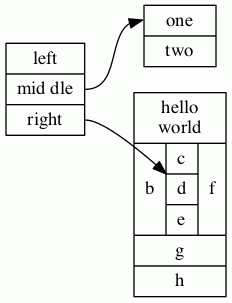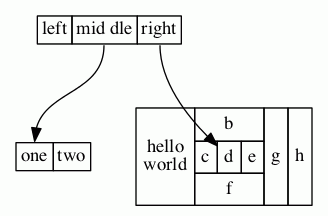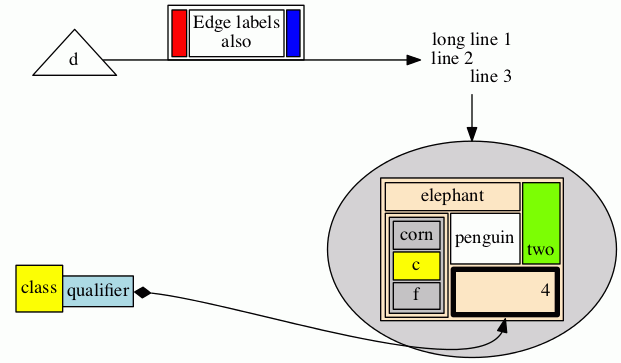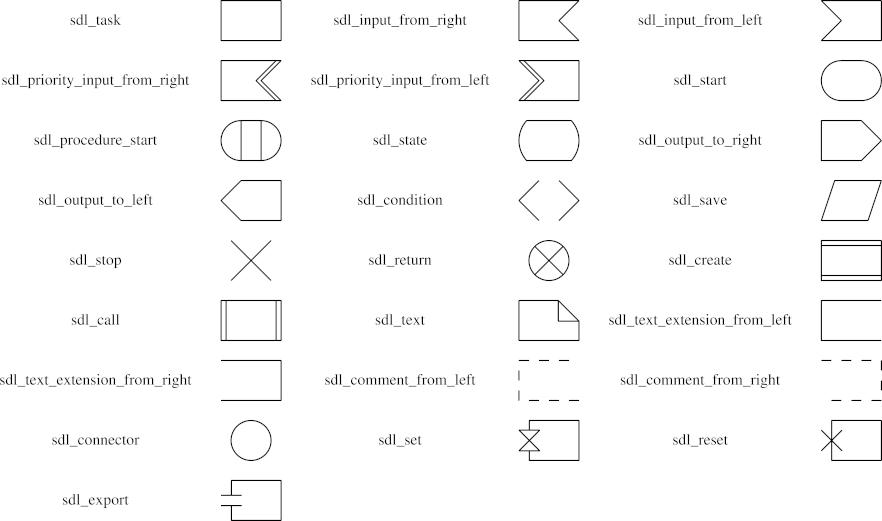


























































The geometry and style of all node shapes are affected by the node attributes fixedsize, fontname, fontsize, height, label, style and width.
The geometries of polygon-based shapes are also affected by the node attributes regular, peripheries and orientation. If shape="polygon", the attributes sides, skew and distortion are also used. If unset, they default to 4, 0.0 and 0.0, respectively. The point shape is special in that it is only affected by the peripheries, width and height attributes.
Normally, the size of a node is determined by smallest width and height needed to contain its label and image, if any, with a margin specified by the margin attribute. The width and height must also be at least as large as the sizes specified by the width and height attributes, which specify the minimum values for these parameters. See the fixedsize attribute for ways of restricting the node size. In particular, if fixedsize=shape, the node's shape will be fixed by the width and height attributes, and the shape is used for edge termination, but both the shape and label sizes are used preventing node overlap. For example, the following graph

Note that the label of the yellow node, with fixedsize=true, overlaps the other node, where there is sufficient space for the gray node with fixedsize=shape.
The shapes: note, tab, folder, box3d and component were provided by Pander. The synthetic biology shapes: promoter, cds, terminator, utr, primersite, restrictionsite, fivepoverhang, threepoverhang, noverhang, assembly, signature, insulator, ribosite, rnastab, proteasesite, proteinstab, rpromoter, rarrow, larrow and lpromoter were contributed by Jenny Cheng.
These are specified by shape values of "record" and "Mrecord". The structure of a record-based node is determined by its label, which has the following schema:
| rlabel | = | field ( '|' field )* |
| where field | = | fieldId or '{' rlabel '}' |
| and fieldId | = | [ '<' string '>'] [ string ] |
The first string in fieldId assigns a portname to the field and can be combined with the node name to indicate where to attach an edge to the node. (See portPos.) The second string is used as the text for the field; it supports the usual escape sequences \n, \l and \r.
Visually, a record is a box, with fields represented by alternating rows of horizontal or vertical subboxes. The Mrecord shape is identical to a record shape, except that the outermost box has rounded corners. Flipping between horizontal and vertical layouts is done by nesting fields in braces "{...}". The top-level orientation in a record is horizontal. Thus, a record with label "A | B | C | D" will have 4 fields oriented left to right, while "{A | B | C | D}" will have them from top to bottom and "A | { B | C } | D" will have "B" over "C", with "A" to the left and "D" to the right of "B" and "C".
The initial orientation of a record node depends on the rankdir attribute. If this attribute is TB (the default) or BT, corresponding to vertical layouts, the top-level fields in a record are displayed horizontally. If, however, this attribute is LR or RL, corresponding to horizontal layouts, the top-level fields are displayed vertically.
As an example of a record node, the dot input

If we add the line

If we change node struct1 to have shape Mrecord,
it then looks like:

Thus, the code

As an example of rounding, dot uses the graph

Additional styles may be available with a specific code generator.
NOTE:The font markups for bold, italic, underlining, subscript and superscript (<B>, <I>, <U>, <SUB> and <SUP>) are only available in versions after 14 October 2011, and the markup for strike-through (<S>) requires versions later than 15 September 2013. In addition, all of these markups are currently only available via the cairo and svg renderers. The horizontal and vertical rules (<HR> and <VR>) are only available in versions later than 8 July 2011.
NOTE:For releases later than 9 September 2014, one can use shape=plain so that the size of the node is totally determined by the label. Otherwise, the node's margin, width and height values may cause the node to be larger, so that edges are clipped away from the label. In effect, shape=plain is shorthand for shape=none width=0 height=0 margin=0.
If the value of a label attribute (label for nodes, edges, clusters, and graphs, and the headlabel and taillabel attributes of an edge) is given as an HTML string, that is, delimited by <...> rather than "...", the label is interpreted as an HTML description. At their simplest, such labels can describe multiple lines of variously aligned text as provided by ordinary string labels. More generally, the label can specify a table similar to those provided by HTML, with different graphical attributes at each level.
As HTML strings are processed like HTML input, any use of the ", &, <, and > characters in literal text or in attribute values need to be replaced by the corresponding escape sequence. For example, if you want to use & in an href value, this should be represented as &.
NOTE: The features and syntax supported by these labels are modeled on HTML. However, there are many aspects that are relevant to Graphviz labels that are not in HTML and, conversely, HTML allows various constructs which are meaningless in Graphviz. We will generally refer to these labels as "HTML labels" rather than the cumbersome "HTML-like labels" but the reader is warned that these are not really HTML. The grammar below describes precisely what Graphviz will accept.
Although HTML labels are not, strictly speaking, a shape, they can be viewed as a generalization of the record shapes described above. In particular, if a node has set its shape attribute to none or plaintext, the HTML label will be the node's shape. On the other hand, if the node has any other shape (except point), the HTML label will be embedded within the node the same way an ordinary label would be.
The following is an abstract grammar for HTML labels. Terminals, corresponding to elements, are shown in bold font, and nonterminals in italics. Square brackets [ and ] enclose optional items. Vertical bars | separate alternatives. Note that, as in HTML, element and attribute names are case-insensitive. (cf. sections 3.2.1 and 3.2.2 of the HTML 4.01 specification).
| label | : | text |
| | | table | |
| text | : | textitem |
| | | text textitem | |
| textitem | : | string |
| | | <BR/> | |
| | | <FONT> text </FONT> | |
| | | <I> text </I> | |
| | | <B> text </B> | |
| | | <U> text </U> | |
| | | <O> text </O> | |
| | | <SUB> text </SUB> | |
| | | <SUP> text </SUP> | |
| | | <S> text </S> | |
| table | : | [ <FONT> ] <TABLE> rows </TABLE> [ </FONT> ] |
| rows | : | row |
| | | rows row | |
| | | rows <HR/> row | |
| row | : | <TR> cells </TR> |
| cells | : | cell |
| | | cells cell | |
| | | cells <VR/> cell | |
| cell | : | <TD> label </TD> |
| | | <TD> <IMG/> </TD> |
Above, a string is any collection of printable characters, including all spaces. Note that outside of the body of a <TD> element, whitespace characters are ignored; within a <TD> element, spaces are preserved but all other white space characters are discarded. HTML comments are allowed within an HTML string. They can occur anywhere provided that, if they contain part of an HTML element, they must contain the entire element.
As is obvious from the above description, the interpretation of white space characters is one place where HTML-like labels is very different from standard HTML. In HTML, any sequence of white space characters is collapsed to a single space, If the user does not want this to happen, the input must use non-breaking spaces " ". This makes sense in HTML, where text layout depends dynamically on the space available. In Graphviz, the layout is statically determined by the input, so it is reasonable to treat ordinary space characters as non-breaking. In addition, ignoring tabs and newlines allows the input text to be formatted for easier reading.
Each of the HTML elements has a set of optional attributes. Attribute values must appear in double quotes.
<!-- Table element -->
<TABLE ALIGN="CENTER|LEFT|RIGHT" BGCOLOR="color" BORDER="value" CELLBORDER="value" CELLPADDING="value" CELLSPACING="value" COLOR="color" COLUMNS="value" FIXEDSIZE="FALSE|TRUE" GRADIENTANGLE="value" HEIGHT="value" HREF="value" ID="value" PORT="portName" ROWS="value" SIDES="value" STYLE="value" TARGET="value" TITLE="value" TOOLTIP="value" VALIGN="MIDDLE|BOTTOM|TOP" WIDTH="value" >
<!-- Table row -->
<TR <!-- No attributes --> >
<!-- Table cell -->
<TD ALIGN="CENTER|LEFT|RIGHT|TEXT" BALIGN="CENTER|LEFT|RIGHT" BGCOLOR="color" BORDER="value" CELLPADDING="value" CELLSPACING="value" COLOR="color" COLSPAN="value" FIXEDSIZE="FALSE|TRUE" GRADIENTANGLE="value" HEIGHT="value" HREF="value" ID="value" PORT="portName" ROWSPAN="value" SIDES="value" STYLE="value" TARGET="value" TITLE="value" TOOLTIP="value" VALIGN="MIDDLE|BOTTOM|TOP" WIDTH="value" >
<!-- Font specification -->
<FONT COLOR="color" FACE="fontname" POINT-SIZE="value" >
<!-- Line break -->
<BR ALIGN="CENTER|LEFT|RIGHT" />
<!-- Image inclusion -->
<IMG SCALE="FALSE|TRUE|WIDTH|HEIGHT|BOTH" SRC="value" />
<!-- Italic style -->
<I <!-- No attributes --> >
<!-- Bold style -->
<B <!-- No attributes --> >
<!-- Underline text -->
<U <!-- No attributes --> >
<!-- Overline text -->
<O <!-- No attributes --> >
<!-- Subscript text -->
<SUB <!-- No attributes --> >
<!-- Superscript text -->
<SUP <!-- No attributes --> >
<!-- Strike-through text -->
<S <!-- No attributes --> >
<!-- Horizontal rule -->
<HR <!-- No attributes --> />
<!-- Vertical rule -->
<VR <!-- No attributes --> />
ALIGN
specifies horizontal placement. When an object is allocated more space than required, this value determines where the extra space is placed left and right of the object.BALIGN
- CENTER aligns the object in the center. (Default)
- LEFT aligns the object on the left.
- RIGHT aligns the object on the right.
- (
<TD> only) TEXT aligns lines of text using the full cell width. The alignment of a line is determined by its (possibly implicit) associated<BR> element.The contents of a cell are normally aligned as a block. In particular, lines of text are first aligned as a text block based on the width of the widest line and the corresponding
<BR> elements. Then, the entire text block is aligned within a cell. If, however, the cell's ALIGN value is"TEXT" , and the cell contains lines of text, then the lines are justified using the entire available width of the cell. If the cell does not contain text, then the contained image or table is centered.
specifies the default alignment ofBGCOLOR="color"<BR> elements contained in the cell. That is, if a<BR> element has no explicit ALIGN attribute, the attribute value is specified by the value of BALIGN.
sets the color of the background. This color can be overridden by a BGCOLOR attribute in descendents. The value can be a single color or two colors separated by a colon, the latter indicating a gradient fill.BORDER="value"
specifies the width of the border around the object in points. A value of zero indicates no border. The default is 1. The maximum value is 255. If set in a table, and CELLBORDER is not set, this value is also used for all cells in the table. It can be overridden by a BORDER tag in a cell.CELLBORDER="value"
specifies the width of the border for all cells in a table. It can be overridden by a BORDER tag in a cell. The maximum value is 255.CELLPADDING="value"
specifies the space, in points, between a cell's border and its content. The default is 2. The maximum value is 255.CELLSPACING="value"
specifies the space, in points, between cells in a table and between a cell and the table's border. The default is 2. The maximum value is 127.COLOR="color"
sets the color of the font within the scope of <FONT>...</FONT>, or the border color of the table or cell within the scope of <TABLE>...</TABLE>, or <TD>...</TD>. This color can be overridden by a COLOR attribute in descendents. By default, the font color is determined by the fontcolor attribute of the corresponding node, edge or graph, and the border color is determined by the color attribute of the corresponding node, edge or graph.COLSPAN="value"
specifies the number of columns spanned by the cell. The default is 1. The maximum value is 65535.COLUMNS="value"
provides general formatting information concerning the columns. At present, the only legal value is "*", which causes a vertical rule to appear between every cell in every row.FACE="fontname"
specifies the font to use within the scope of <FONT>...</FONT>. This can be overridden by a FACE attribute in descendents. By default, the font name is determined by the fontname attribute of the corresponding node, edge or graph.FIXEDSIZE
specifies whether the values given by the WIDTH and HEIGHT attributes are enforced.GRADIENTANGLE="value"
- FALSE allows the object to grow so that all its contents will fit. (Default)
- TRUE fixes the object size to its given WIDTH and HEIGHT. Both of these attributes must be supplied.
gives the angle used in a gradient fill if the BGCOLOR is a color list. For the default linear gradient, this specifies the angle of a line through the center along which the colors transform. Thus, an angle of 0 will cause a left-to-right progression. For radial gradients (see STYLE), the angle specifies the position of the center of the coloring. An angle of 0 places the center at the center of the table or cell; an non-zero angle places the fill center along that angle near the boundary.HEIGHT="value"
specifies the mininum height, in points, of the object. The height includes the contents, any spacing and the border. Unless FIXEDSIZE is true, the height will be expanded to allow the contents to fit. The maximum value is 65535.HREF="value"
attaches a URL to the object. Note that the "value" is treated as an escString similarly to the URL attribute.ID="value"
allows the user to specify a unique ID for a table or cell. See the id attribute for more information. Note that the "value" is treated as an escString similarly to the id attribute.POINT-SIZE="value"
sets the size of the font, in points, used within the scope of <FONT>...</FONT>. This can be overridden by a POINT-SIZE attribute in descendents. By default, the font size is determined by the fontsize attribute of the corresponding node, edge or graph.PORT="value"
attaches a portname to the object. (See portPos.) This can be used to modify the head or tail of an edge, so that the end attaches directly to the object.ROWS="value"
provides general formatting information concerning the rows. At present, the only legal value is "*", which causes a horizontal rule to appear between every row.ROWSPAN="value"
specifies the number of rows spanned by the cell. The default is 1. The maximum value is 65535.SCALE
specifies how an image will use any extra space available in its cell. Allowed values areSIDES="value"If this attribute is undefined, the image inherits the imagescale attribute of the graph object being drawn. As with the imagescale attribute, if the cell has a fixed size and the image is too large, any offending dimension will be shrunk to fit the space, the scaling being uniform in width and height if SCALE="true". Note that the containing cell's ALIGN and VALIGN attributes override an image's SCALE attribute.
- FALSE : keep image its natural size. (Default)
- TRUE : scale image uniformly to fit.
- WIDTH : expand image width to fill
- HEIGHT : expand image height to fill
- BOTH : expand both image width height to fill
specifies which sides of a border in a cell or table should be drawn, if a border is drawn. By default, all sides are drawn. The "value" string can contain any collection of the (case-insensitive) characters 'L', 'T', 'R', or 'B', corresponding to the left, top, right and, bottom sides of the border, respectively. For example, SIDES="LB" would indicate only the left and bottom segments of the border should be drawn.SRC="value"
specifies the image file to be displayed in the cell. Note that if the software is used as a web server, file system access to images is more restricted. See GV_FILE_PATH and SERVER_NAME.
STYLE
specifies style characteristics of the table or cell. Style characteristics are given as a comma or space separated list of style attributes. At present, the only legal attributes are "ROUNDED" and "RADIAL" for tables, and "RADIAL" for cells. If "ROUNDED" is specified, the table will have rounded corners. This probably works best if the outmost cells have no borders, or their CELLSPACING is sufficiently large. If it is desirable to have borders around the cells, use HR and VR elements, or the COLUMNS and ROWS attributes of TABLE.TARGET="value"The "RADIAL" attribute indicates a radial gradient fill. See the BGCOLOR and GRADIENTANGLE attributes.
determines which window of the browser is used for the URL if the object has one. See W3C documentation. Note that the "value" is treated as an escString similarly to the target attribute.TITLE="value"
sets the tooltip annotation attached to the element. This is used only if the element has a HREF attribute. Note that the "value" is treated as an escString similarly to the tooltip attribute.TOOLTIP="value"
is an alias for TITLE.
VALIGN
specifies vertical placement. When an object is allocated more space than required, this value determines where the extra space is placed above and below the object.WIDTH="value"
- MIDDLE aligns the object in the center. (Default)
- BOTTOM aligns the object on the bottom.
- TOP aligns the object on the top.
specifies the mininum width, in points, of the object. The width includes the contents, any spacing and the border. Unless FIXEDSIZE is true, the width will be expanded to allow the contents to fit. The maximum value is 65535.
There is some inheritance among the attributes. If a table specifies a CELLPADDING, CELLBORDER or BORDER value, this value is used by the table's cells unless overridden. If a cell or table specifies a BGCOLOR, this will be the background color for all of its descendents. Of course, if a background or fill color is specified for the graph object owning the label, this will be the original background for the label. The object's fontname, fontcolor and fontsize attributes are the default for drawing text. These can be overridden by using FONT to set new values. The new font values will hold until overridden by an enclosed FONT element. Finally, the pencolor or color of the graph object will be used as the border color.
If you want horizontal or vertical rules used uniformly within a table, consider using the COLUMNS or ROWS attributes rather than using many HR and VR elements.
Because of certain limitations in handling tables in a device-independent manner, when BORDER is 1 and both table and cell borders are on and CELLSPACING is less than 2, anomalies can arise in the output, such as gaps between sides of borders which should be abutting or even collinear. The user can usual get around this by increasing the border size or the spacing, or turning off the table border.
As an example of HTML labels, the dot input

As usual, an HTML specification is more verbose. On the other hand, HTML labels are much more general, as the following example shows:

The source for this graph can be found here.
Here is an example using <FONT> elements

with the input graph.
Here is an example using an <IMG> element

with the input graph.
The sides attribute (version 2.37 and later) allows one to combine cells to form various non-convex shapes. For example, a tee-shaped node

can be produced using
The table below gives the shape names and the corresponding node shapes.
